Software Development Lifecycle Models: the Ultimate Guide
The software development market is expected to reach $1039 billion by 2027 compared to $390 billion in 2020. But do you know the software development life cycle, and why does it appear so difficult initially?
The software development life cycle or SDLC is a continuous procedure that begins when the decision to launch the project is made and ends when it is completely removed from exploitation. There is no such thing as a universal SDLC model. They are classified based on certain criteria, and each strategy has advantages and disadvantages.
For example, an app must be built, and a team is formed to focus on a specific product element, with complete freedom to do so. One of the developers decides to start with design, the other begins with coding, and the third with documentation. It would result in project failure, hence strong knowledge and understanding among team members are required to achieve the intended product.
Just do not make mistakes in choosing the right model for your project, when report from Statista states that the biggest part of software development expenses consists of:
- 755 billion USD on enterprise software
- 33 billion USD on mobile apps in Q2 2022
The SDLC models outline how the process is organized and in what sequence possible risks and issues are eliminated. In this post, we discover the SaaS software development life cycle models, their usage and benefits and examine what processes they entail!
Mục lục bài viết
Software development life cycle
Software development life cycle or SDLC is a process used by the industry to design, develop and test high-quality software. SDLC aims to produce high-quality software that meets or exceeds customer expectations and requirements, closes in the shortest possible time, and helps you estimate costs as you know the pipelines and stages of software development.
SDLC provides a well-structured sequence of stages that enables an organization to swiftly deliver top-notch software that has been thoroughly tested and is suitable for production usage. The life cycle determines the methodology for improving software quality and the overall development process.
The main advantages of using the SDLC include:
- managing projects more effectively
- ensuring meeting the deadlines
- reducing the cost and development time
- improving quality
The SDLC framework exists to help reduce lead product times, ensure better performance, save budget, and increase the potential benefit of your product to the stakeholders you care about. The SDLC is particularly useful in software development because it forces you to work within strict limits.
So, how does the Software Development Life Cycle work?
Step 1: Planning and needs analysis – “What are the issues and opportunities to achieve?”
Planning of quality assurance requirements and identifying project risks is carried out during the planning software development life cycle phases.
Step 2: Definition of requirements – “What do we want?”
The next step is to clearly define and document the product requirements and approve them from the customer or market analysts.
Step 3: Product Design – “How will we get what we want?”
The design of all modules of the proposed architecture should be clearly defined with the smallest detail in the Design document.
Step 4: Development– “Let’s create what we want.”
If the design is detailed and organized, code writing can be done without hassle. Developers should follow the coding guidelines defined by their organization and programming tools.
Step 5: Product testing – “Did we get what we want?”
This step is usually a subset of all stages, as in modern SDLC models, testing mainly affects all software development life cycle stages.
Step 6: Deployment and maintenance – “Let’s start using what we got. And get this closer to what we want.”
Once the product is tested and ready for deployment, it is released on the market.
Types of SDLC models
The two primary software development life cycle models are heavyweight and lightweight. Heavyweight or predictive processes indicate that the scope of work is known ahead of time. At TechMagic, we use it to simplify and coordinate large projects.
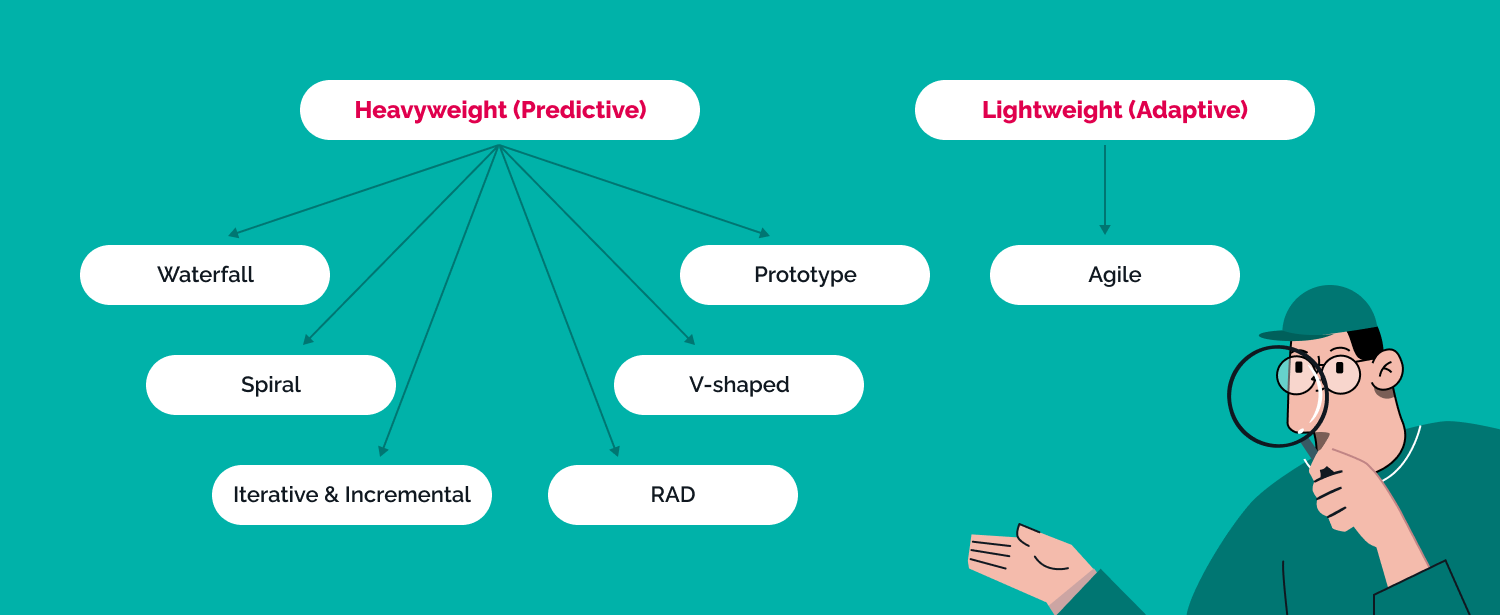
Among the predictive (heavyweight) models are the following:
- Waterfall
- Spiral
- V-shaped
- Iterative
- RAD
- Prototype
Lightweight or agile procedures are often known as adaptable. In terms of a software life cycle, agile approaches need far less documentation.
Adaptable (adaptive) SDLC model is:
- Agile
Let’s look at the differences between these models.
Software development Life Cycle models
Waterfall model
Based on Statista report, 26% of companies use the Waterfall method in 2022.
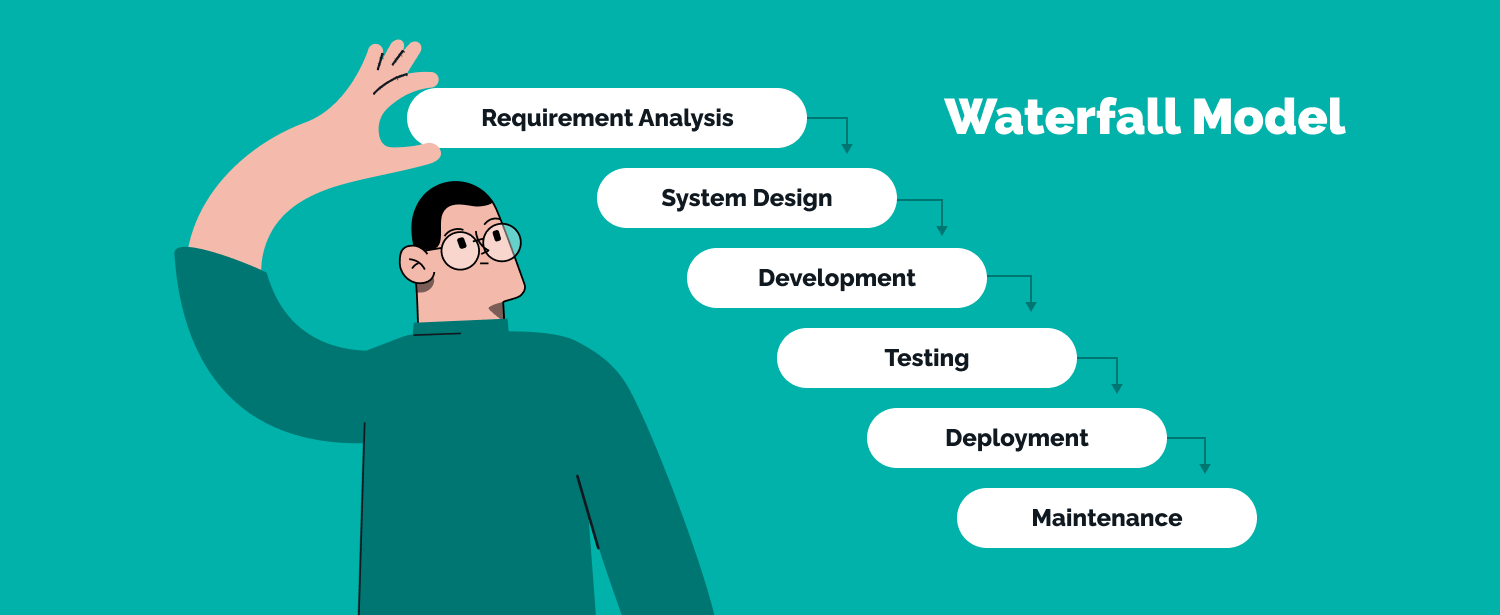
The first SDLC methodology used for software development was the waterfall model.
A linear sequential life cycle model is another name for it. There are no matches between the stages in the waterfall model, and each step must be finished before the subsequent phase can start. Here, every step of the development process may start only after the one before it has been finished.
- Requirements Analysis: All possible requirements for the system under development are fixed.
- System Design: This system design helps define hardware and system requirements and helps define the overall system architecture.
- Development: Based on the initial design data, engineers develop the system as small programs called modules integrated into the next phase.
- Testing: Each module created during the implementation phase is tested before being incorporated into the overall system. Following integration, the entire system is examined for flaws and defects.
- Deployment: After functional and non-functional testing is finished, the product is deployed in the client environment or made available for purchase.
- Maintenance: Patches are provided to address these issues and enhance the product.
When to use the Waterfall model?
- If requirements are well documented, clear, and fixed, usually for small teams
- If technology is clear and not dynamic, for example for healthcare/military projects
- If the project is short such as a landing page
Waterfall model benefits:
- Basic, manageable and easy-to-understand and use model
- All SDLC life cycle phases are completed step by step and clearly defined
- Deliverables of each phase are precisely defined
- Each stage has tangible results and review process
- Phases are processed and completed one at a time
- Simple to organize tasks
- The process and results are documented
Waterfall model drawbacks:
- Lots of risk and uncertainty
- Adjusting the volume over the life cycle can complete the project
- Integration is carried out as a «big bang» at the very end
- Time-consuming and cannot be employed in short-term projects (exception landing page)
- Any change in the later SDLC life cycle stages would result in higher costs
V-shaped model
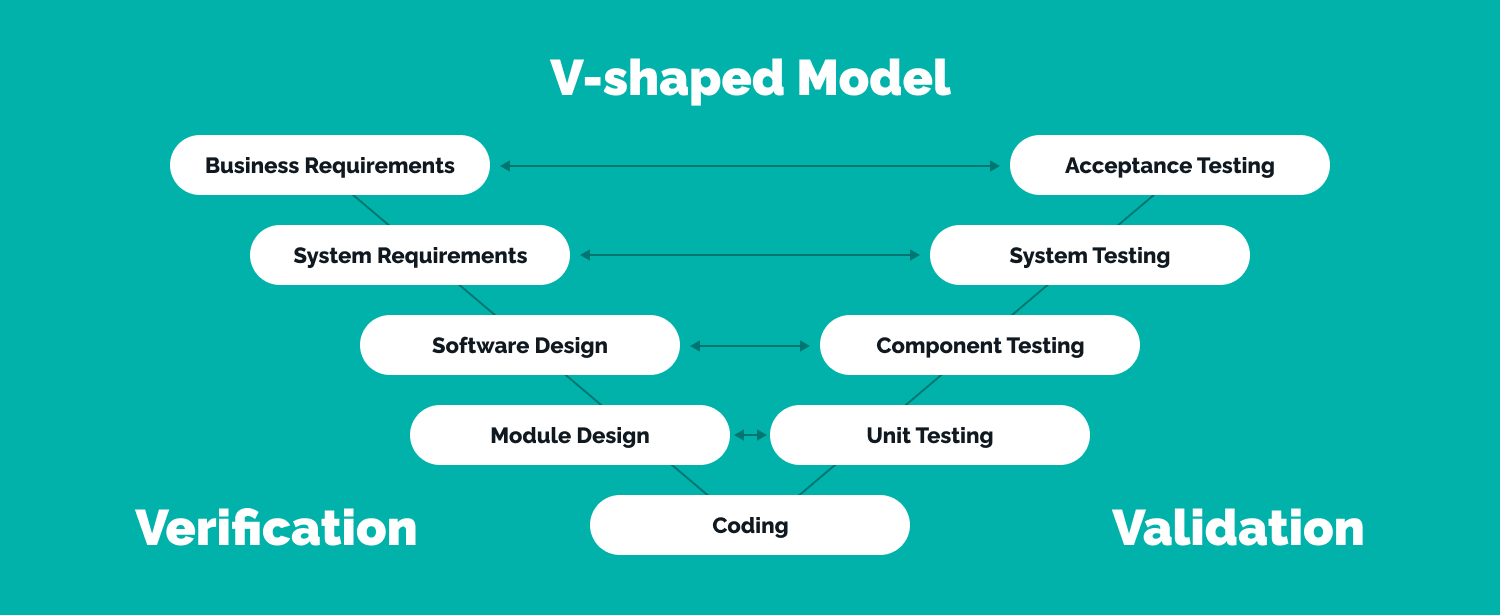
Another name for the V-Model is the Verification and Validation Model. This technique assumes that development and testing take place simultaneously since verification and validation go hand in hand.
Before the project begins, the criteria must be extremely clear because return and modification are frequently expensive. It is a well-defined model, and each step only starts after the one before it is finished.
The V-model has several steps in design and testing phase:
- Business requirements: The validation project planning is done, as business requirements can be used as input data for acceptance testing.
- System Requirements: The system design, as well as the whole hardware and communication infrastructure for building a product, are all incorporated.
- Software Design: During software system development life cycle, testing plan is developed based on system design. Doing this earlier leaves more time for the actual test to be completed later.
- Module Design: The system fragments into little modules during this stage. Specification of the modules’ intricate design, commonly known as Low-Level Design (LLD).
V-shaped model testing phase consists of:
- Acceptance testing: In a user environment that mirrors the production environment and how the system has been delivered, it satisfies user requirements, and it is prepared for deployment.
- System testing: It evaluates the functioning, interdependence, and communication of the entire application and both the application’s functional and non-functional needs.
- Component testing: The system is tested as the components are integrated during integration testing. In the architecture design phase, integration testing is done. This test confirms that modules can communicate with one another.
- Unit testing: These unit test plans are conducted to get rid of defects at the level of the code or unit.
And links these two phases Coding. The actual coding of system modules developed during the design phase is considered during the coding phase. The most appropriate programming language choice is based on system and architectural requirements.
When to use a V-shaped model?
- If requirements are clearly defined, and documented
- If the technology is not dynamic
V-shaped model benefits:
- Easy to understand and apply
- Works well for small projects where requirements are very well understood.
- Each stage has concrete results and review process
V-shaped model drawbacks:
- High risk and uncertainty
- Not flexible to change
- Not a good model for complex and object-oriented, long and ongoing projects
Spiral model
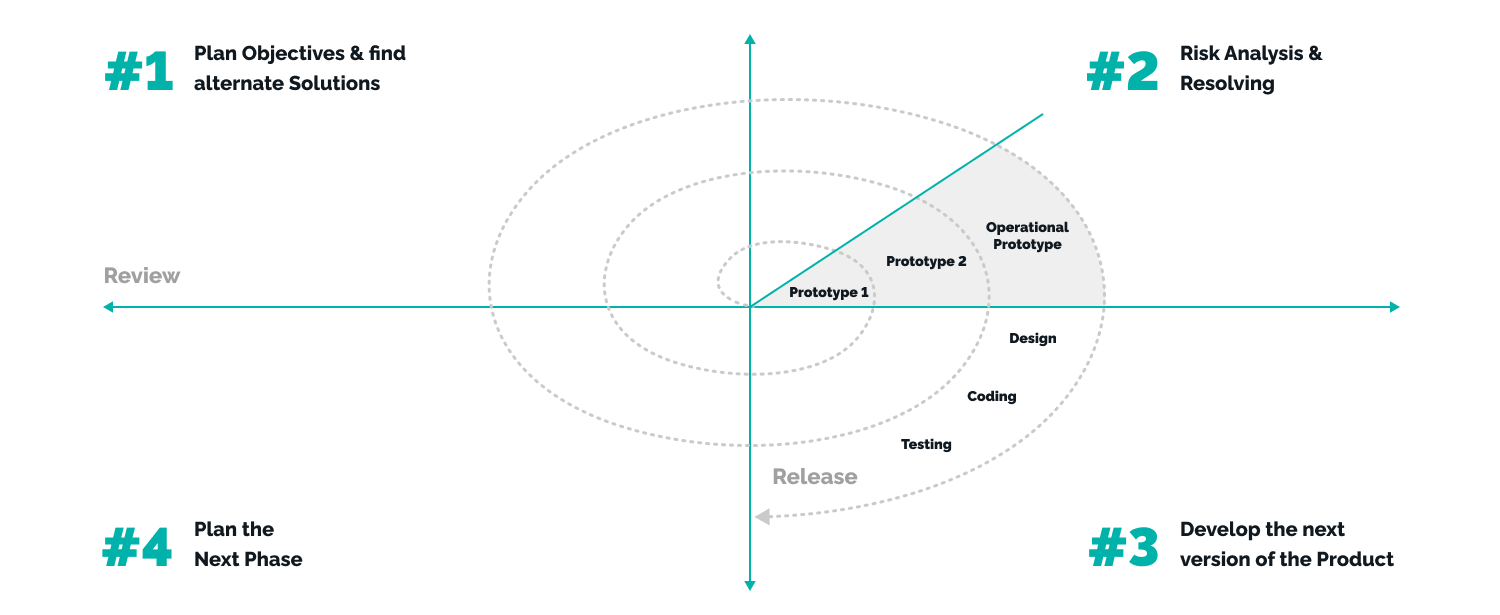
Spiral model, is a waterfall methodology with a strong emphasis on risk analysis, which combines an iterative development model and a sequential linear development model.
Fourth-generation programming languages, rapid application development prototyping, and risk analysis are added to the waterfall technique. While this method greatly reduces risk, it may not fit the budget and is used differently depending on the application.
Spiral model has the following stages:
- Determine objectives: This phase begins with the collection of business requirements in the basic spiral.
- Identify risks: It includes the identification, assessment, and monitoring of technical feasibility and management risks, such as slippage and cost overruns.
- Plan the next iteration: Here the development and testing of the indicated characteristics take place. The new software version is ready at the conclusion of the third quarter.
- Development and test: In the baseline, when the product is only thought through and the design is developed, this phase is developed by POC (Proof of Concept) to obtain customer feedback.
When to use the spiral model?
- If risk assessment is important and budgets are tight
- If long-term commitment to the project change over time
- If the client is unsure of his requirements or they are complex and unclear
Spiral SDLC model benefits are:
- Changes in requirements can be accommodated
- Allows wide use of prototypes
- Users are involved early in the development of the system
- Requirements can be fixed more precisely
- Development can be divided into smaller parts
Spiral SDLC model drawbacks are:
- Strict controls are required to complete such products
- Risk of running the spiral in an indefinite cycle
- The end of the project may be unknown early
- Not suitable for small or low-risk projects and can be expensive for small projects
- The complex process of management
- Lots of documentation
Incremental and Iterative model
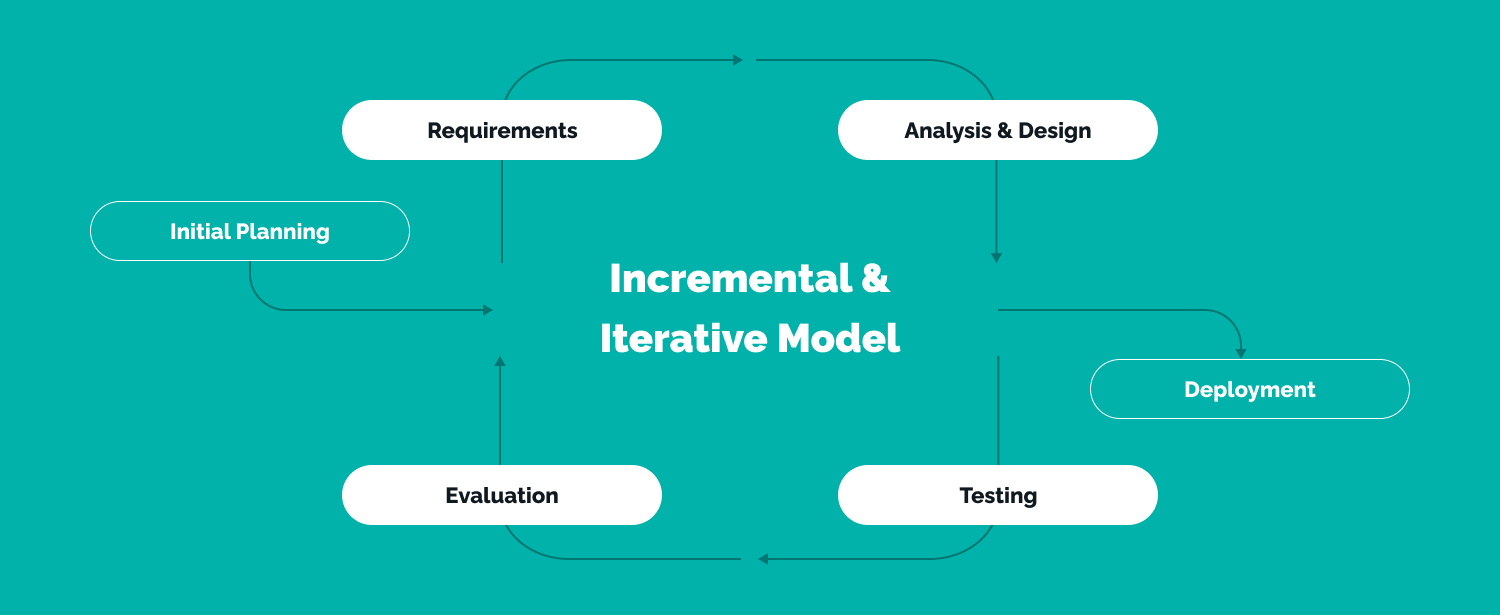
Simple implementation of a condensed set of software requirements marks the beginning of the iterative phase. Up until the entire system is developed and prepared for deployment, it incrementally grows development versions.
A complete requirements specification is not attempted to be the first step in the iterative life cycle model. Instead, only a portion of the program is defined and implemented at first, and then it is examined to ascertain other needs. After each model iteration, this procedure is repeated, producing a new software version.
This approach’s major goal is to build the system incrementally, over repeated cycles, and with smaller chunks at a time (gradually). Verifying requirements and testing and testing each software version under requirements in each model cycle are essential to the iterative software development life cycle’s success.
Iterative and incremental software development life cycle:
- Initial planning and requirements: It creates a strategy and timeframe for the first iteration cycle, sketches out the first requirements, and collects the documentation during this phase.
- Analysis and design: During this phase, technological requirements, database models, and business needs are summed up based on the strategy and make an algorithm, schematic, or functioning architecture that complies with your criteria.
- Deployment: Developers create the functionality and design necessary to satisfy the requirements.
- Testing: Here,what isn’t functioning or performing as expected is determined and solved. Users, testers, and stakeholders offer their opinions and personal experiences.
- Evaluation: In this stage, we compare this iteration against the specifications and targets.
When to use these models?
- If requirements for a complete system are clearly defined
- If there’s a time limit to go to the market
- If the team explores new technology during the project
- If some high-risk features may change
Iterative and incremental SDLC model benefits are:
- Operational functionality can be developed quickly
- Working system model may exist at the early development stage
- Measured progress
- Early identification of problems
- Costly to change the scope/requirements
- Eliminated risks during iteration
- Easily to manage risk
- Software is produced at an early that provides customer feedback
Iterative and Incremental SDLC model drawbacks are:
- Not suitable for changing requirements
- More management attention
- There may be problems with architecture or system design, as not all requirements are assembled at the beginning of the entire life cycle
- The end of the project may be unknown, which is a risk
- Risk analysis requires highly skilled resources
RAD model
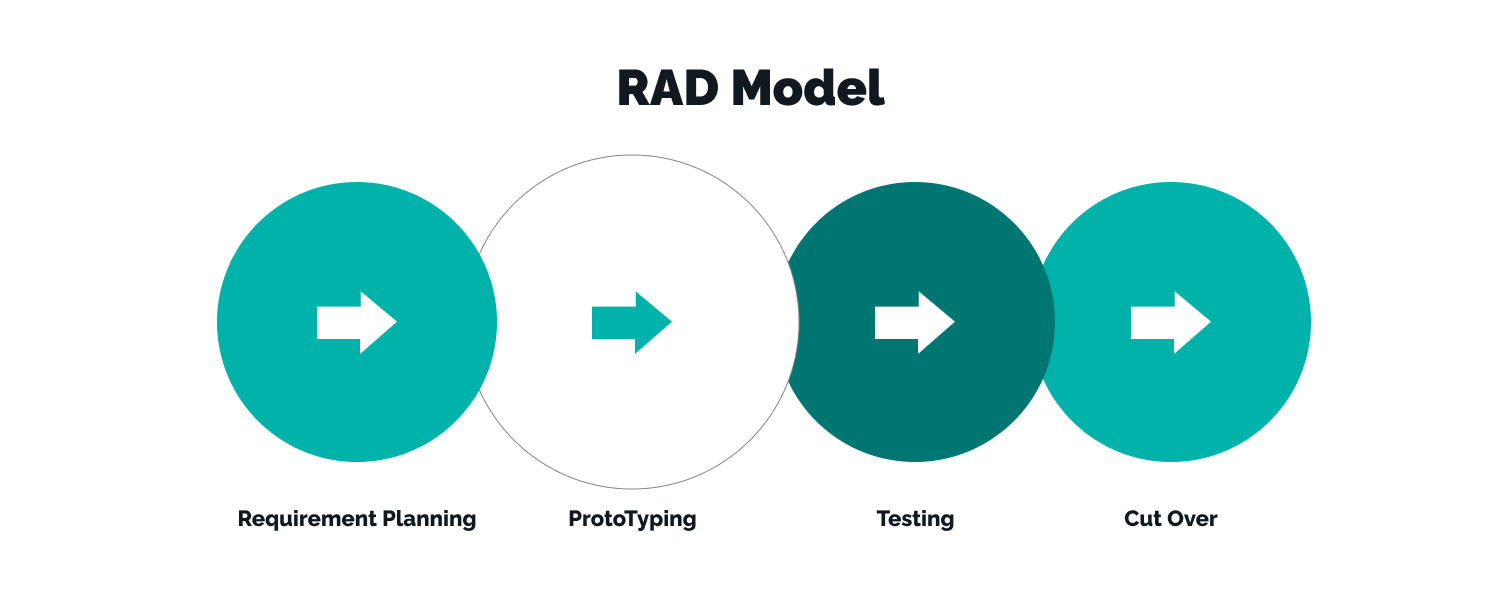
The Rapid Application Development methodology is built on iterative development and prototyping with little preparation. The process of creating software entails product development planning. Functional modules are built in parallel as prototypes for speedier product delivery and then integrated to form a full product.
The RAD breaks down the steps of analysis, design, assembly, and testing into short iterative development cycles.
When can the RAD model be used?
- If the system is modular to deliver it gradually
- If designers are highly available for modeling
- If the budget allows automatic code-generation tools
RAD model benefits are:
- Progress can be measured
- Fast delivery as it reduces the overall development time due to the ability to reuse components and parallel development
- Shorten iteration time
- Reducing development time
- Increasing the reusability of components
RAD model drawbacks are:
- Dependence on technically strong team members to determine requirements
- Modular system can be built using RAD
- High dependence on modelling skills
- Suitable for component-based and scalable systems, for short development projects
- Need user involvement throughout the life cycle
Prototype model
The creation of software prototypes that reflect the functionality of the product being developed but may not contain the exact logic of the original software is referred to as software prototyping.
Software prototyping is becoming increasingly popular as a software development model because it allows for an early understanding of customer requirements. This allows for valuable client feedback and helps software developers understand exactly what is expected of the developed product.
Prototype model benefits:
- Increased user involvement in the product before its implementation
- Reduced time and costs as defects can be detected much earlier
- Faster user feedback is available, leading to better solutions
- Missing functionality can be easily identified
- Complex or complex functions can be defined
Prototype model drawbacks:
- Risk of insufficient requirements analysis due to too much dependence on the prototype
- Users can get entangled in prototypes and real systems
- Developers may try to reuse existing prototypes to create a real system, even if this is not technically feasible
- The effort invested in prototyping can be too great if not properly controlled
Agile model
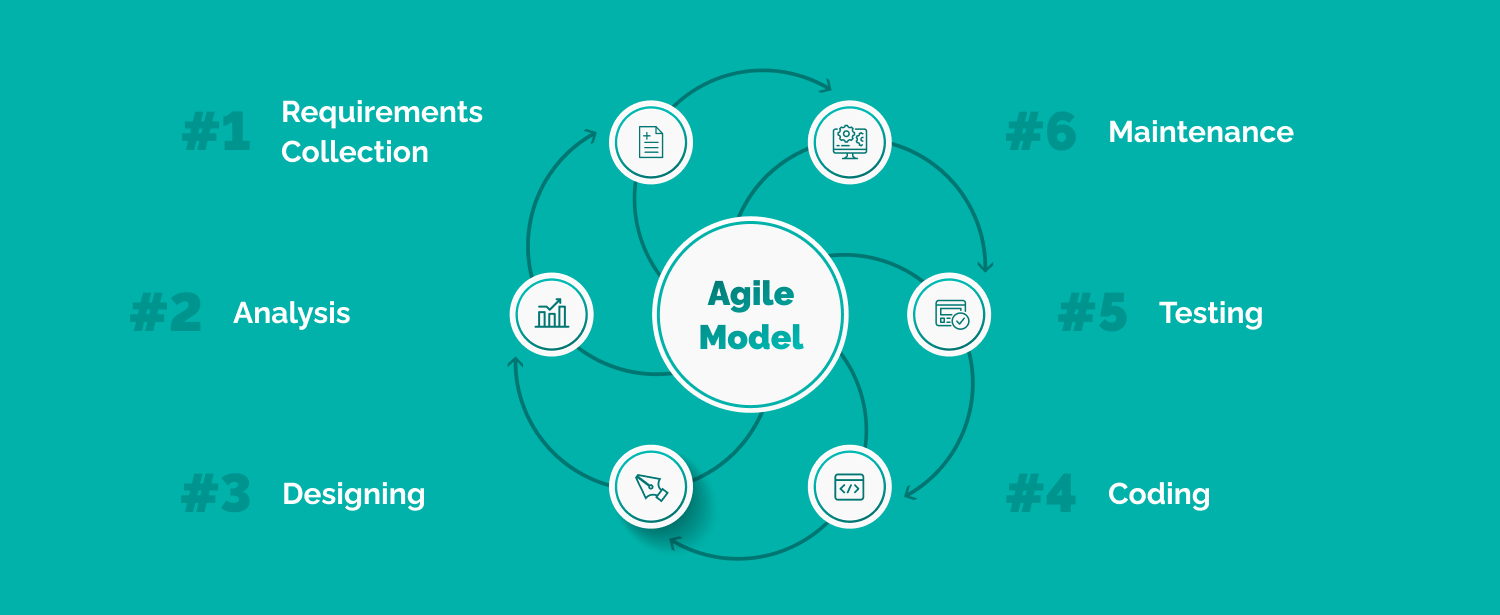
37% of worldwide companies use the Agile method in 2022. A functioning software product is quickly delivered as part of the Agile SDLC, emphasizing process flexibility and customer satisfaction. Tasks are broken down into time limits to offer specific features for release. According to the Agile software development life cycle model, each project should be managed uniquely and current methodologies should be tailored to the project’s needs.
Iterations of these assemblies are supplied. Typically, an iteration lasts one to three weeks. Cross-functional instructions that operate concurrently across many domains are included in each iteration.
Agile standard SDLC stages are:
- Scheduling
- Requirements analysis
- Design
- Development
- Unit and acceptance testing
 how we built
how we built
Agile Model benefits are:
- Teamwork and cross-training
- Resource requirements are minimal
- Suitable for fixed or changing requirements
- Minimum rules, documentation, easy to use
- Provides development and delivery in the overall planned context
- Little or no planning is required
- Simple to operate
Agile Model drawbacks are:
- Not suitable for handling complex dependencies
- More risk of stability, repairability and extensibility
- Strict delivery management to meet deadlines
- Onboarding new team members can be difficult due to a lack of documentation
Each of these techniques differs somewhat from the others. Still, they all serve the same purpose: to assist teams in delivering high-quality software as rapidly and cost-effectively as feasible.
Tips to choose the right SDLC model
When selecting the SDLC system development life cycle, there is a danger of becoming overwhelmed by the different possibilities. We create a table to organize all of the questions and techniques. They label the boxes with “+” or “-.” Then selecting the best alternative becomes quite simple.
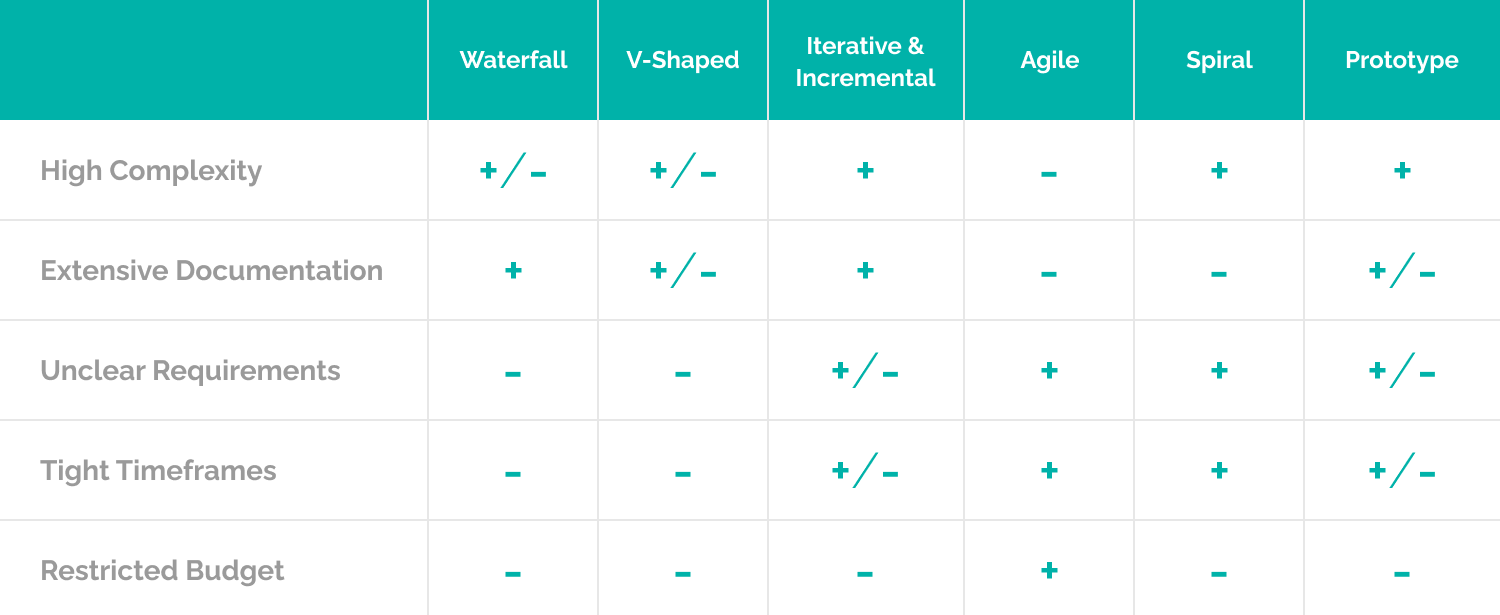
Another important point is that the present models may be optimized in any case. You are not required to follow all instructions blindly. They are there to assist you through the process, but you can shorten the time of the steps or add more if you think it is essential.
Final word
When done correctly, SDLC may provide the greatest management control and documentation level. Developers understand why and what they should develop. All stakeholders agree on the goal and see a clear method for getting there.
SDLC models serve as a foundation for the software development process. They also offer each team member a clearly defined strategy so that everyone understands what they’re doing, why they’re doing it, and what the end aim is.
Several hazards might convert an SDLC implementation into a hindrance to development rather than a tool that aids us. Failure to consider the demands of customers, other users and stakeholders can result in a poor grasp of the system requirements from the start.
Want to improve application development quality and monitor application performance at every stage of the SDLC? Contact TechMagic to help your organization at producing higher-quality software
FAQs
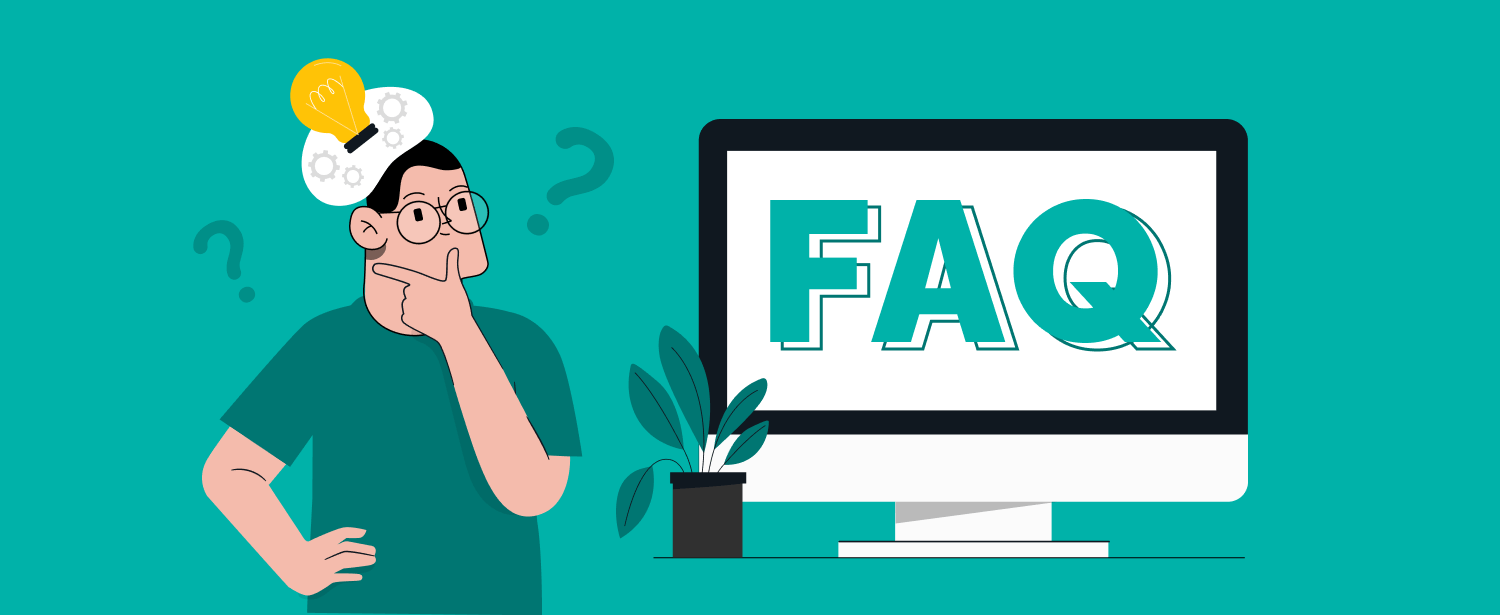
What is the SDLC life cycle?
Software development life cycle (SDLC) is a software development model representing a process or series of processes required to produce software by creating, testing, delivering, and maintaining software.
What is the first step of the system development life cycle (SDLC)?
The first step is the analysis phase, during which you gather information about your stakeholders and competitors, their needs, and any barriers to achieving your goals. This step also includes identifying your technology needs and where you plan to fit in the market.











